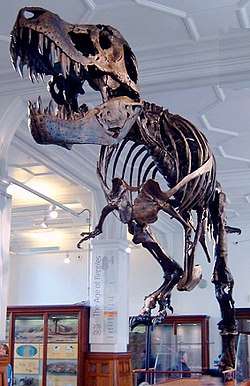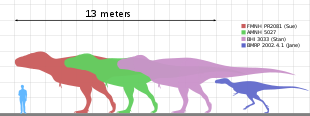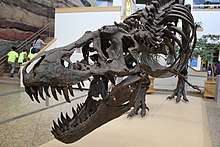Stan (dinosaur)
"Stan", also known by its inventory number BHI 3033, is a Tyrannosaurus rex fossil found in the Hell Creek Formation in South Dakota, just outside of Buffalo in 1987, and excavated in 1992.[1] It is the fifth most complete T. rex fossil discovered to date, at more than 70% bulk.[2][3]

Discovery
Stan Sacrison, an amateur paleontologist, was responsible for the initial discovery of Stan's bone fragments, and as a result is the namesake for the T. rex. He was out looking at plant life in South Dakota when he spotted Stan's pelvis visible in the side of a cliff.[3] At the time, Sacrison was doing freelance work for the Black Hills Geological Institute.[4] Originally, it was thought that the fossil was that of a triceratops.[5]
The excavation itself required the skills and resources of the Black Hills Institute; it officially began on 11 July 1992, led by Peter Larson (the lead paleontologist on the excavations of many other T. rex specimens like Sue and Trix and the institute's president).[3][4] The institute's team removed the rock above Stan's skeleton with a Bobcat and finer removal was done manually with picks and brushes until the fossils could be plotted and diagrammed with the help of a grid placed over the dig site. The bones were then wrapped in burlap and plaster and brought to the Black Hills Institute.[1]
Description

The most notable aspect of Stan is his nearly complete and perfectly preserved skull. It is widely regarded as the best T. rex skull ever discovered.[3] Although the bones were separated from each other before excavation, they were in pristine condition and ideal for study by researchers.[1] According to Pete Larson of the Black Hills Institute, Stan's skull has enabled scientists to learn more about the T. rex's cranial kinesis, or movement of the skull bones, than any other T. rex specimen.[6] Because of Stan's narrow pelvis, paleontologists are confident that the specimen is male.[1] Stan is approximately 11.7 meters long in length as measerured by the Hutchinson study back in 2011[7], 12 feet (3.64 m) tall at the hip, and is estimated to be around 66 million years old.[8][2] Like other specimens of Tyrannosaurus Stan has had many estimates made on its possible weight. More recent body mass estimates for this specimen are 7.6 tonnes from the Bates study in 2009[9] 5.9 to 10.8 tonnes in Hutchsinson 2011[10] and 7.2 tonnes in Sellers 2017[11].
Preparation

The bones of Stan the T. rex were cleaned and prepared at the Black Hills Institute where resident paleontologists and paleobotanists continued to study him and the fossilized plants he was discovered with. The institute has performed two additional excavations of the site that Stan was discovered, yielding 199 of the 350 known bones of the T. rex, more than 70% in bulk, which made Stan the second most complete T. rex until 2017.[1]
Since then, additional excavations for other known T. rex specimens, as well as new discoveries regarding the T. rex "Scotty" (RSM P2523.8) in 2019, have made Stan the fifth most complete T. rex.[12] However, BHI 3033 is still one of the most famous T. rex discoveries, and more than sixty casts of his skeleton are display and requested by museums all around the world.[8][6]
Life and death
Stan's fossils show notable signs of wear and indication that the dinosaur experienced multiple attacks and illnesses throughout his life. Puncture wounds on the back of his skull and rib indicate that he was at one point bitten by another T. rex.[2] Other bite marks at the base of his skull suggest his neck was once broken and caused the fusion of two vertebrate, resulting in a loss of mobility and pain for the rest of his life. The injury spurred the growth of excess bone around his neck, showing a remarkable recovery. Other irregularities in Stan's skull include non-symmetrical holes on either side of his jaw with smoothed edges, which are indications that these are more healed wounds.[1][3]
According to the Black Hills Institute, Stan likely lived in a family unit of other T. rex. His mate could have been the cause of some of his injuries.[3] Stan likely ate hadrosaurids, also known as duck-billed dinosaurs, such as Edmontosaurus or Parasaurolophus.[8][3] It is unknown what exactly caused Stan's death, but many theories suggest that it could have been the result of old age, starvation due to limited mobility from his injuries, or even parasitic infections that many T. rex exhibit signs of.[13]
In 2005, the BBC program The Truth About Killer Dinosaurs used Stan's skull as a model for their hydraulic test of the T. rex's bite force and estimated that it exceeded 6.8 tonnes. Additional tests, like those published by Karl T. Bates 2009, used Stan's remains to study the weight distribution of T.rex, as well as how their mass and proportions would have affected their movement. Bates estimated that Stan was larger than previous belief, at around 16,875 pounds (7.6 tonnes); he also concluded that Stan, as well as other Tyrannosaurus rex specimens, were much more robust than commonly believed.[14]
Exhibition

It took more than 30,000 hours for the Black Hills Institute to prepare the fossil for display; he was the centerpiece for the opening of the T. rex World Exhibition and toured around Japan before coming to reside in the Black Hills Institute's Hall of Dinosaurs.[3][6] Stan is the most duplicated T. rex fossil, and as a result, more people have seen Stan (and casts of Stan) than any other Tyrannosaurus.[15][6]
The New Mexico Museum of Natural History is home to a cast of BHI 3033. The museum purchased the cast in 2008, and it remains a center piece of the museum, which is home to numerous other dinosaur fossils, notable T. rex skulls, and skull fragments.[8] Another cast resides at Walt Disney World Resort in Orlando, Florida, which is also home to a cast of Sue.[3]
Other casts are displayed at the Houston Museum of Natural Science, the National Museum of Natural History (Washington, D.C.), the National Museum of Natural Science (Tokyo), the Sternberg Museum of Natural History (Fort Hays, Kansas), the Wyoming Dinosaur Center (Thermopolis, Wyoming), the Manchester Museum (Manchester, UK), the Children's Museum of Indianapolis, Indiana, the Dinosaur Discovery Museum (Kenosha, WI), and the Weis Earth Science Museum (Menasha, WI). While it has been reported that the Googleplex T. rex replica in Mountain View, California, United States is a replica of BHI-3033[16], it is actually a cast of MOR-555[17][15][18]
Intellectual Property
Stan's skeleton, including original and restored elements, is a registered copyright of Black Hills Institute of Geological Research with the registration number of VA0001745359[19]. This copyright was defended in 2010 when it was noticed that casts of "Peck's rex" contained unmodified cast replicas of elements of both Sue and Stan[20].
References
- nandi (2 January 2018). "Stan the Tyrannosaurus rex". Paleontology World. Retrieved 4 April 2019.
- "All About Stan | New Mexico Museum of Natural History & Science". www.nmnaturalhistory.org. Retrieved 4 April 2019.
- "BHI/Fossils & Minerals/Dinosaurs and Birds/STAN T. rex". bhigr.com. Retrieved 4 April 2019.
- Browne, Malcolm W. (27 July 1993). "Dinosaur Institute Keeps Digging". The New York Times. ISSN 0362-4331. Retrieved 4 April 2019.
- arms, I. Know Dino: The Big Dinosaur Podcast | A. site about dinosaurs | This Week in Dinosaur News: A. possible explanation for alvarezsaurids’ tiny; Sauropodomorph, A. New; Says, More (26 September 2018). "I Know Dino Podcast Show Notes: T. rex revisited (Episode 200)". I Know Dino: The Big Dinosaur Podcast. Retrieved 4 April 2019.
- Brave Wilderness (14 September 2018), The Most Famous Dinosaur Tooth!, retrieved 4 April 2019
- https://journals.plos.org/plosone/article/figure/image?size=large&id=10.1371/journal.pone.0026037.t003
- "Rare T. rex footprints in New Mexico help round out picture of prehis…". archive.is. 11 September 2012. Archived from the original on 11 September 2012. Retrieved 4 April 2019.
- https://journals.plos.org/plosone/article/figure/image?size=large&id=info:doi/10.1371/journal.pone.0004532.t002
- https://journals.plos.org/plosone/article/figure/image?size=large&id=10.1371/journal.pone.0026037.t006
- https://peerj.com/articles/3420/
- "Paleontologists report world's biggest Tyrannosaurus rex: Nicknamed 'Scotty,' the record-breaking rex is also the largest dinosaur skeleton ever found in Canada". ScienceDaily. Retrieved 4 April 2019.
- Wolff, Ewan D. S.; Salisbury, Steven W.; Horner, John R.; Varricchio, David J. (30 September 2009). "Common Avian Infection Plagued the Tyrant Dinosaurs". PLoS ONE. 4 (9): e7288. doi:10.1371/journal.pone.0007288. ISSN 1932-6203. PMC 2748709. PMID 19789646.
- Sellers, William I.; Hodgetts, David; Manning, Phillip L.; Bates, Karl T. (19 February 2009). "Estimating Mass Properties of Dinosaurs Using Laser Imaging and 3D Computer Modelling". PLOS ONE. 4 (2): e4532. doi:10.1371/journal.pone.0004532. ISSN 1932-6203. PMC 2639725. PMID 19225569.
- "The Stan Gallery". EXTINCT MONSTERS. 2 February 2014. Retrieved 4 April 2019.
- "On Google campus, a dinosaur is forever in battle with hordes of flamingos". Boing Boing. Retrieved 4 April 2019.
- Harlan, Bill (15 November 2019). "South Dakota T. rex draws media attention". Rapid City Journal. Retrieved 12 December 2019.
- "Morian Hall of Paleontology | Houston Museum Of Natural Science". www.hmns.org. Retrieved 4 April 2019.
- "Copyright Catalog (1978 to Present)". United States Copyright Office. Department of Interior. Retrieved 12 December 2019.
- Penzenstadler, Nick (26 November 2010). "T-Rex center of $8.2M area copyright lawsuit". Rapid City Journal. Retrieved 12 December 2019.